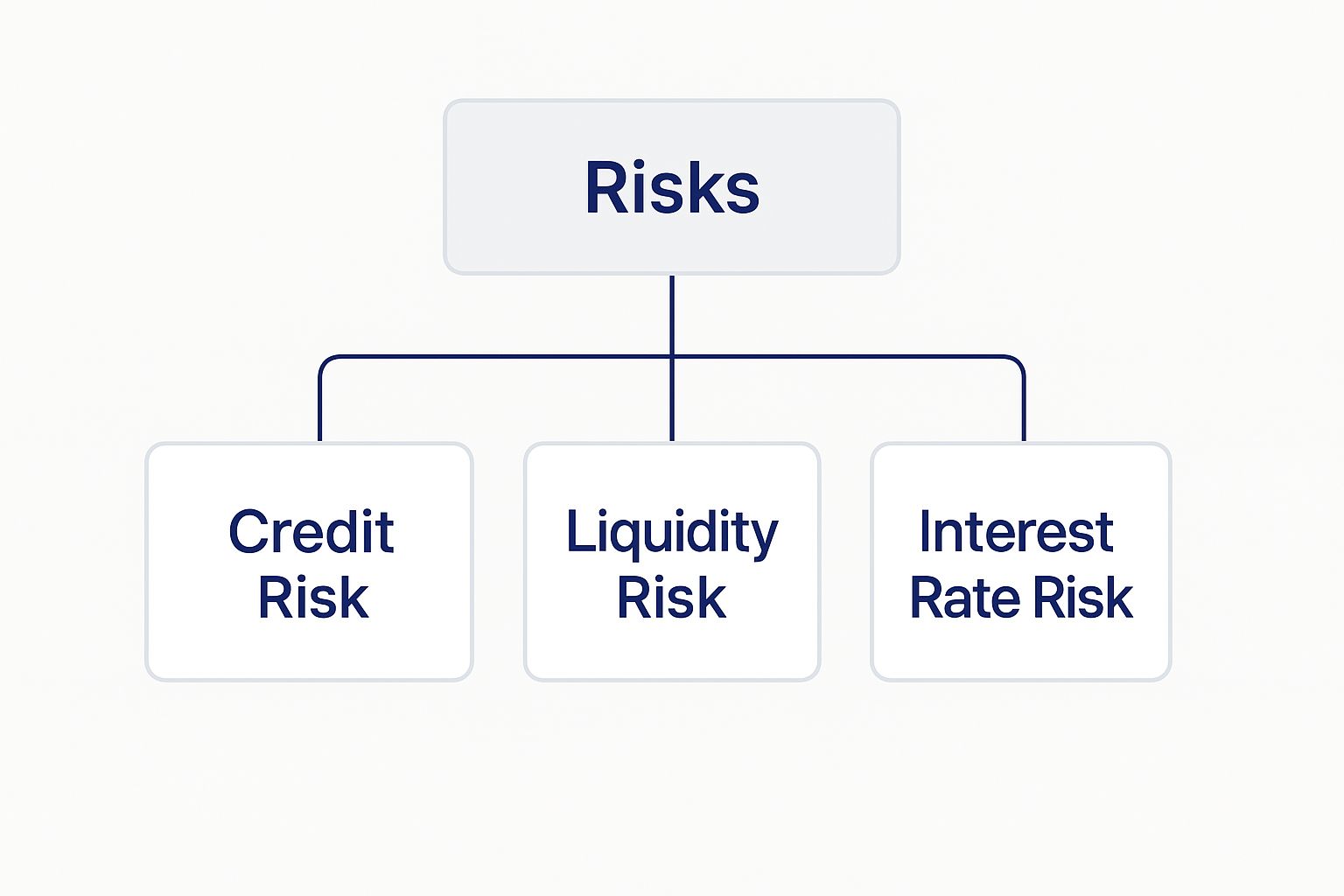A Guide to Private Credit Funds: The Modern Investor's Playbook
- Ryan McDowell

- Jul 31
- 13 min read
Reading Time: 8 min | Good for: Novice (A), Informed (B), Sophisticated (C)
Not long ago, the term private credit funds was jargon you'd only hear in the halls of institutional finance. Now, it's a core topic in family offices and among sophisticated investors everywhere. What is it? Put simply, private credit funds are pools of capital that lend money directly to companies, taking over a role that used to belong almost exclusively to big banks.
TL;DR: The Bottom Line on Private Credit
What It Is: Private funds lending directly to companies, filling the gap left by banks. It's now a multi-trillion-dollar core alternative asset class.
Why It Matters for Your Portfolio: Delivers attractive, often floating-rate income, lower volatility than public markets, and stronger investor protections. It's a powerful tool for income, diversification, and inflation hedging.
Next Step: Understand the different strategies (from senior debt to opportunistic) and how to evaluate a fund manager's track record, discipline, and alignment of interests.
The Rise of Private Credit as a Core Alternative

For decades, if a mid-sized company needed a loan—whether to expand, buy a competitor, or just refinance—their first and only call was to a bank. That's not the case anymore. The financial landscape changed dramatically after the 2008 global financial crisis, as new regulations made it harder and more expensive for traditional banks to lend, especially to small and medium-sized enterprises (SMEs).
This created a massive financing gap. Private credit funds stepped in to fill that void, offering capital with a speed and flexibility that banks often couldn't match. They’ve since become a critical engine for corporate growth.
A New Mainstream Asset Class
What started as a niche corner of the alternative investment world has exploded into a market powerhouse.
Market Signal Box * The Data: As of early 2024, private credit assets under management (AUM) reached approximately $1.7 trillion globally, a significant leap from just over $875 billion in 2020, according to data from Preqin. * Interpretation: This isn't just a fleeting trend; it's a structural shift in capital markets. Banks continue to face regulatory constraints, cementing private credit's role as an essential capital provider for the middle market. * Investor Take: Private credit is no longer an experimental side bet. It has matured into a mainstream alternative, offering a durable, income-generating strategy that is less correlated to the daily drama of public stock and bond markets.
This rapid growth has cemented private credit's place as an essential source of capital for companies that might be too small or specialized for traditional lenders. If you're curious, you can learn more about the factors driving this expansion and why it has captured the attention of sophisticated allocators.
Private Credit At a Glance
Attribute | Description |
|---|---|
What It Is | Direct lending from investment funds to private companies. |
Typical Borrowers | Small to medium-sized enterprises (SMEs) and private equity-backed companies. |
Key Investor Benefit | Generates consistent, often floating-rate income with lower volatility than public markets. |
Role in a Portfolio | Diversifier, income generator, and a potential inflation hedge. |
Common Loan Types | Senior secured loans, unitranche loans, mezzanine debt, and distressed debt. |
This table is just the starting point, of course. The real value comes from understanding why this asset class has become so popular with family offices and other institutional investors.
Why Sophisticated Investors Are Turning to Private Credit
The appeal of private credit funds goes way beyond just filling a market gap. Investors are drawn to a handful of key features that align perfectly with goals like long-term wealth preservation and building a truly diversified portfolio.
Here’s a quick rundown of what makes this asset class so compelling today:
Attractive, Predictable Income: Most loans from private credit funds have floating interest rates. This is a game-changer. When benchmark rates go up, the interest payments on these loans go up too, creating a natural hedge against inflation and a reliable income stream.
Lower Volatility: These loans aren't traded on a public exchange, so they're insulated from the wild daily swings of the stock and bond markets. The result is a much smoother return profile and less overall portfolio whiplash.
Strong Covenants and Protections: Because fund managers negotiate loan terms directly with the borrowing company, they can build in strong investor protections. Think strict financial requirements (covenants) and claims on collateral, which can significantly improve the odds of getting money back if a borrower defaults.
For busy family office principals or anyone new to this space, grasping these core benefits is the first step. It helps you see how private credit can be a powerful tool for fortifying a modern investment portfolio.
How Private Credit Funds Actually Work

So, how does the engine of a private credit fund actually run? The best way to think about it is like an exclusive, professionally managed lending club for businesses.
Instead of friends pooling money, this club is made up of sophisticated investors who entrust their capital to a seasoned management team. That team then finds, vets, and lends money to established, mid-sized companies. At the center of it all, you have two key players: the General Partner (GP) and the Limited Partners (LPs).
The Key Players: General Partners and Limited Partners
The General Partner (GP) is the fund manager—the boots-on-the-ground team doing all the heavy lifting. In our world, this would be a firm like Stiltsville Capital. The GP handles everything from raising the initial capital and sourcing deals to conducting rigorous due diligence, structuring the loans, and monitoring the portfolio companies. You're essentially investing in their expertise.
The Limited Partners (LPs) are the investors who supply the capital. This group usually consists of family offices, high-net-worth individuals, pension funds, and endowments. As an LP, your role is largely passive; you commit the funds and trust the GP to manage them wisely. Your liability is also "limited" to your investment amount, which shields your other assets.
This GP/LP setup creates a clean separation of duties. LPs provide the fuel (capital), and the GP drives the vehicle (manages the investments).
Mapping the Fund Structure and Capital Flow
The way money moves through a private credit fund is methodical, governed by a legal roadmap called the Limited Partnership Agreement (LPA).
Capital Commitments: LPs don't write a massive check on day one. Instead, they make a capital commitment, a formal pledge to provide a specific amount of money over the fund's life.
Capital Calls: When the GP finds a compelling lending opportunity, they issue a "capital call" to the LPs. This is the official request for a portion of their committed capital to fund the new loan.
Investment Period: For the first few years, the GP operates in the investment period, actively deploying the called capital by originating loans.
Harvesting Period: Once the investment period ends, the focus pivots to managing the existing loan portfolio and "harvesting" returns as companies make interest payments and repay principal.
Distributions: That cash—both the original capital and the profits—is then distributed back to the LPs according to a "waterfall" structure.
This phased approach is incredibly efficient. It ensures capital is deployed strategically and isn't just sitting idle, a concept known as minimizing "dry powder."
Aligning Interests Through Fees and Waterfalls
To keep the GP laser-focused on generating strong returns, the fee structure is designed with a powerful alignment of interests.
Novice Lens: Why Fees Matter Think of it like hiring a pro to manage your rental property. You pay them a small monthly fee for maintenance (the management fee). But their real payday (carried interest) comes from a share of the profits only after you’ve gotten your entire initial investment back, plus a bonus return (preferred return). This motivates them to make that property as profitable as possible for you.
The structure is built on two main components:
Management Fee: A small annual fee, typically 1.5% to 2.0% of committed or invested capital, paid to the GP to cover operational expenses—salaries, office space, legal work, and deal sourcing.
Carried Interest (or "Carry"): The GP's share of the fund's profits. Crucially, it only kicks in after the LPs have received 100% of their original investment back, plus a pre-agreed minimum return known as the preferred return or "hurdle rate," often around 8%.
This profit-sharing model, often called a "distribution waterfall," is designed to ensure LPs get paid first. It’s a powerful incentive to protect capital and hunt for the best returns, transforming a simple lending activity into a true strategic partnership.
Understanding the Spectrum of Private Credit Strategies
Private credit isn't a one-size-fits-all investment. Think of it as a broad landscape of different lending strategies, each with its own unique risk-and-return DNA. Understanding this spectrum is key to aligning an allocation with your specific goals, whether that's steady income, higher growth, or a blend of both.
The strategies boil down to where the loan sits in a company’s capital structure, the borrower's credit quality, and the situation driving the need for capital.
Direct Lending: The Workhorse of Private Credit
Direct lending is the largest and most common strategy. You can think of it as the private market's version of traditional corporate banking. In this space, funds provide senior secured loans directly to established, middle-market companies to finance growth, acquisitions, or refinancings. Because these loans are "senior" and "secured," they sit at the top of the capital structure and are backed by the company’s assets. This provides a significant layer of protection, making it a relatively lower-risk strategy focused on generating consistent, floating-rate income.
Mezzanine Debt: A Hybrid Approach
Sandwiched between senior debt and pure equity, mezzanine debt is a hybrid instrument that pulls features from both worlds. It’s subordinate to senior loans but ranks ahead of equity, offering a higher potential return to compensate for its junior position in the payback line. What makes mezzanine financing compelling is that it often includes an "equity kicker"—like warrants or a conversion feature—giving the lender a small piece of ownership. This provides upside potential beyond just interest payments, fitting investors with a slightly higher risk tolerance. To dig deeper, explore our detailed guide to mezzanine debt funds for sophisticated investors.
Distressed Debt and Special Situations
This is the most opportunistic end of the spectrum. Here, funds invest in the debt of companies facing financial distress or going through a major event like a bankruptcy or restructuring. The strategy is often to buy the debt at a deep discount, then actively participate in the company's turnaround to unlock value. This approach requires deep expertise in complex legal and restructuring processes and carries higher risk, but it also offers the potential for equity-like returns.
The diagram below maps out the core risks that managers across all these strategies must navigate.

Advanced Lens: The Capital Stack Imagine a company's financing as a multi-story building. * Ground Floor (Senior Debt): Safest, first to get paid in a liquidation. Typically floating-rate loans with strong collateral. Lower risk, lower return. * Middle Floors (Mezzanine Debt): Riskier, paid after senior debt. Unsecured or junior lien, often with an equity component (warrants) to boost returns. * Penthouse (Equity): Highest risk, but also highest potential reward. Last to get paid. Where a private credit fund invests in this "stack" determines its fundamental risk and return profile.
Why Investors Are Pouring Into Private Credit Funds

Now that we've covered the different strategies, the big question is: why are so many sophisticated investors dedicating serious capital to private credit funds? The answer isn't just about filling a gap left by traditional banks. It's about a powerful mix of benefits that perfectly aligns with the goals of family offices and high-net-worth individuals—namely, generating resilient income and preserving wealth through all market cycles.
The Allure of Higher, Floating-Rate Yields
The most immediate draw of private credit is its potential for higher yields compared to public debt with similar risk profiles, like broadly syndicated loans or corporate bonds. This extra return, often called an "illiquidity premium," is simply compensation for locking up capital for a longer period.
But here’s the real kicker: the vast majority of these loans are floating-rate. This means the interest paid by the borrower adjusts with prevailing benchmark rates (like SOFR). In an inflationary environment where central banks are hiking rates, the income from a private credit portfolio rises right along with them. It’s a natural, built-in hedge against inflation—a massive advantage over fixed-rate bonds, which lose value as rates climb.
Powerful Diversification and Lower Volatility
Private credit investments don't trade on public exchanges. This insulates them from the daily mood swings and sentiment-driven volatility of the stock and bond markets. The value of these loans is tied to one thing: the fundamental financial health and cash flows of the borrowing company, not market noise.
This creates several powerful effects for a portfolio:
Reduced Portfolio Volatility: Adding private credit can act as a shock absorber, smoothing out the bumps during public market downturns.
Low Correlation: Historically, private credit returns have moved independently of traditional stocks and bonds, making it a true diversifier that can improve a portfolio's overall risk-adjusted returns.
Focus on Fundamentals: Performance is driven by disciplined underwriting and borrower creditworthiness, not fleeting market trends or headlines.
Enhanced Investor Protections
Because these deals are privately negotiated, the lender has real leverage. Experienced managers can bake strong investor protections directly into the loan agreement—covenants and terms that are often missing in the standardized world of public debt. These protections allow managers to be true partners to their borrowers while keeping a sharp, disciplined focus on protecting investor capital. The growing dealmaking environment, with ongoing M&A activity, only highlights this advantage. As more deals require specialized financing, the flexibility of private credit becomes even more valuable, fueling the growth of private credit markets.
Your Investor Checklist for Sizing Up a Private Credit Fund
Picking the right private credit fund isn't just about chasing returns; it's about finding a partner you can trust for the long haul. A thorough, disciplined review is your best defense against surprises. Think of it like a pre-flight check before committing capital on a multi-year journey.
1. Manager Experience and Track Record
How long has the core investment team worked together through multiple market cycles?
Can the manager provide a fully realized track record for prior funds with a similar strategy (not just cherry-picked highlights)?
What is their specific history with loan defaults and workouts? Ask for hard data on loss rates and recovery amounts.
2. Strategy and Deal Sourcing
How does the fund source its deals? Is it reliant on auctioned deals from investment banks or does it have a proprietary, relationship-based network?
What is the fund's specific "Insight Edge" in a crowded market?
Does the fund have a deep focus on certain industries or does it invest as a generalist? Niche expertise can be a powerful advantage.
Deal Lens Example: Illustrative Senior Secured Loan * The Scenario: A private credit fund lends $20 million to a profitable software company to acquire a smaller competitor. * The Structure: The loan is structured as senior secured debt, giving the fund the first claim on all the company's assets. * The Terms: The interest rate is SOFR + 6.0% (floating), and the agreement includes strict covenants requiring the company to maintain profitability and limit additional debt. * The Result: This structure provides the fund's investors a predictable, inflation-hedged income stream with strong downside protection, all backed by tangible collateral.
3. Risk Management and Discipline
"Walk me through your due diligence and underwriting process. Who on the investment committee has the power to kill a deal?"
What are the fund's hard limits on portfolio concentration (single company, industry, or geography)?
How does the team monitor portfolio companies after the loan is made? Ask about the frequency of financial reporting and management check-ins.
4. Alignment of Interests (Fees & Terms)
Are the management fees calculated on committed capital or invested capital? (The latter is generally more LP-friendly).
What is the preferred return ("hurdle") and the carried interest percentage?
Does the GP co-invest a significant amount of their own capital into the fund alongside the LPs?
Risks and Mitigations in Private Credit
Every investment carries risk. A top-tier manager is proactive about identifying and neutralizing threats. Understanding these common risks—and how a good manager prepares for them—is a critical part of your due diligence.
Risk: Credit/Default Risk * Mitigation: Deep, bottom-up due diligence on each borrower. Securing loans with valuable collateral and negotiating strong protective covenants.
Risk: Interest Rate Risk * Mitigation: Primarily using floating-rate loans, which adjust with market rates and protect income streams in a rising-rate environment.
Risk: Concentration Risk * Mitigation: Setting strict portfolio limits on single-company, industry, and geographic exposure to ensure robust diversification.
Risk: Manager/Operational Risk * Mitigation: Investing with experienced teams that have a long, verifiable track record of navigating different economic cycles together.
Risk: Illiquidity Risk * Mitigation: Matching the fund's lock-up period to the expected life of the underlying loans, ensuring capital is available to meet obligations without forced sales.
Getting this evaluation right is critical. A fund with fair, investor-friendly terms signals a manager who sees you as a true partner, not just a source of capital.
Ready to Invest? Here's How
So, you’ve done your homework and understand the fundamentals of private credit funds. Taking the first step is more straightforward than you might think. It’s a structured path designed for transparency and to ensure a strong fit between you and the fund manager.
The Investment Process, Step by Step
Initial Contact & Qualification: It all starts with an introductory call. This is a two-way interview where the fund manager learns your goals and confirms you meet the necessary “Accredited Investor” status.
Due Diligence: If there's a mutual fit, the manager will share the core legal documents: the Private Placement Memorandum (PPM), the Limited Partnership Agreement (LPA), and the Subscription Agreement. This is your time to perform your own deep dive.
Executing the Subscription Agreement: Once you’re confident in the strategy, team, and terms, you'll complete and sign the Subscription Agreement. This is the legal document formalizing your commitment to invest.
Funding Your Investment: You won't wire your entire investment on day one. Instead, the manager will issue "capital calls" as they find and close on loans, putting your money to work incrementally.
The Stiltsville Capital Perspective: We believe a great investment partnership starts with transparency and education. Our process is built to give you a crystal-clear picture of our entire strategy—from how we source deals to how we manage risk—so you can make your decision with total confidence.
At the end of the day, a well-chosen private credit allocation can be an incredibly resilient and smart addition to your portfolio. When sourced through a disciplined partner, it's a powerful tool for building wealth through any economic cycle. To see how this fits into a broader asset allocation strategy, check out our [2024 guide on how to invest in commercial real estate](https://www.stiltsvillecapital.com/post/how-to-invest-in-commercial-real-estate-a-2024-guide).
Frequently Asked Questions (FAQ)
What is the typical minimum investment for a private credit fund?
For institutional-quality funds targeting UHNWIs and family offices, minimum commitments typically start in the $250,000 to $1 million range, and sometimes higher. The specific minimum is always detailed in the fund’s Private Placement Memorandum (PPM).
How liquid are investments in private credit funds?
They are fundamentally illiquid. Unlike public stocks or bonds, there is no ready market to sell your position. You should be prepared to commit your capital for the full life of the fund, which is typically a 5 to 10-year period. This illiquidity is a core feature, not a bug, and is the source of the potential return premium.
How is private credit different from private equity?
The distinction is crucial.
Private Equity (PE) *buys* the company. PE funds are in the ownership business, seeking returns from capital appreciation upon selling the company.
Private Credit (PC) *is* the bank. PC funds are in the lending business, seeking returns from the steady, contractual flow of interest payments. This creates an income-focused return stream with greater downside protection, as lenders are paid before owners in a liquidation.
At Stiltsville Capital, we believe a successful investment partnership starts with a crystal-clear understanding of both the opportunities and the realities of any asset class.
If you have more questions or want to explore how a disciplined private markets strategy could fit into your own portfolio, let's talk. We invite you to schedule a confidential call with our team.
Information presented is for educational purposes only and does not constitute an offer to sell or a solicitation of an offer to buy securities. Any offering is made only through definitive offering documents (e.g., private placement memorandum, subscription agreement) and is available solely to investors who meet applicable suitability standards, including “Accredited Investor” status under Rule 501 of Regulation D. Investments in private real estate involve risk, including loss of capital, illiquidity, and no guarantee of distributions. Past performance is not indicative of future results. Verification of accredited status is required for participation in Rule 506(c) offerings.





Comments